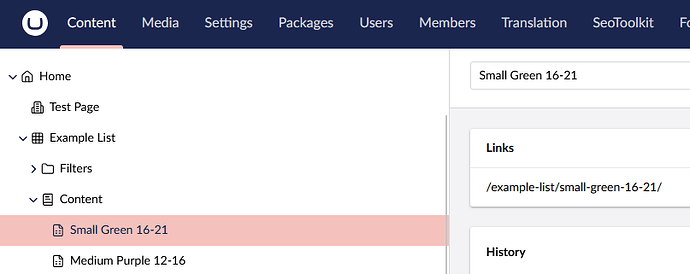I would like to amend Umbraco’s URL generation for v15 to selectively exclude certain doctypes from the URL structure, for example going from:
/list-page/contents/example-item
to:
/list-page/example-item
In a separate thread on the same topic, another user was given the suggestion of porting the functionality offered by a third-party package called “Dotsee.Discipline” which currently only supports U13 - the source for this feature can be found here. I’m trying to achieve this, but have run into a problem with the URL provider.
When the provider attempts to generate a URL for a page with a virtual node in its path, a stack overflow exception occurs after repeated recursions to base.GetUrl via ConstructUrl. The code I am porting does mention this occurring whenever the Content.Url field is used, but now this appears to be happening on when GetUrl is called too - does anybody know more about the latest changes to Umbraco’s internals which may be causing this?
For reference, this is the code I have so far - it’s very similar to the code in the Dotsee package:
URL provider:
public class VirtualNodesUrlProvider : DefaultUrlProvider
{
private readonly GlobalSettings _globalSettings;
private readonly IUmbracoContextFactory _umbContextFactory;
private readonly VirtualNodesHelpers _virtualNodesHelpers;
public VirtualNodesUrlProvider(IOptionsMonitor<RequestHandlerSettings> requestSettings, ILogger<DefaultUrlProvider> logger, ISiteDomainMapper siteDomainMapper, IUmbracoContextAccessor umbracoContextAccessor,
UriUtility uriUtility, ILocalizationService localizationService, IOptions<GlobalSettings> globalSettings, IUmbracoContextFactory umbContextFactory, VirtualNodesHelpers virtualNodesHelpers)
: base(requestSettings, logger, siteDomainMapper, umbracoContextAccessor, uriUtility, localizationService)
{
_globalSettings = globalSettings.Value;
_umbContextFactory = umbContextFactory;
_virtualNodesHelpers = virtualNodesHelpers;
}
public override UrlInfo GetUrl(IPublishedContent content, UrlMode mode, string culture, Uri current)
{
//Just in case
if (content == null)
{ return null; }
//If this is a virtual node itself, no need to handle it - should return normal URL
bool hasVirtualNodeInPath = false;
foreach (IPublishedContent item in content.Ancestors()) //.Union(content.Children())
{
if (_virtualNodesHelpers.IsVirtualNode(item))
{
hasVirtualNodeInPath = true;
break;
}
}
using (var umb = _umbContextFactory.EnsureUmbracoContext())
{
var _urlInfo = hasVirtualNodeInPath ? ConstructUrl(umb.UmbracoContext, content.Id, current, mode, content, culture) : null;
return _urlInfo;
}
}
private UrlInfo ConstructUrl(IUmbracoContext umbracoContext, int id, Uri current, UrlMode mode, IPublishedContent content, string culture)
{
string path = content.Path;
//Keep path items in par with path segments in url
//If we are hiding the top node from path, then we'll have to skip one path item (the root).
//If we are not, then we'll have to skip two path items (root and home)
int pathItemsToSkip = (_globalSettings.HideTopLevelNodeFromPath == true) ? 2 : 1;
//Get the path ids but skip what's needed in order to have the same number of elements in url and path ids.
string[] pathIds = path.Split(',').Skip(pathItemsToSkip).Reverse().ToArray();
//Get the default url
//DO NOT USE THIS - RECURSES: string url = content.Url;
//https://our.umbraco.org/forum/developers/extending-umbraco/73533-custom-url-provider-stackoverflowerror
//https://our.umbraco.org/forum/developers/extending-umbraco/66741-iurlprovider-cannot-evaluate-expression-because-the-current-thread-is-in-a-stack-overflow-state
string url = null;
try
{
url = base.GetUrl(content, mode, culture, current).Text;
}
catch (NullReferenceException ex)
{
return null;
}
//If we come from an absolute URL, strip the host part and keep it so that we can append
//it again when returing the URL.
string hostPart = "";
if (url.StartsWith("http"))
{
Uri u = new Uri(url);
url = url.Replace(u.GetLeftPart(UriPartial.Authority), "");
hostPart = u.GetLeftPart(UriPartial.Authority);
}
//Strip leading and trailing slashes
if ((url.EndsWith("/")))
{
url = url.Substring(0, url.Length - 1);
}
if ((url.StartsWith("/")))
{
url = url.Substring(1, url.Length - 1);
}
//Now split the url. We should have as many elements as those in pathIds.
string[] urlParts = url.Split('/').Reverse().ToArray();
//Iterate the url parts. Check the corresponding path id and if the document that corresponds there
//is of a type that must be excluded from the path, just make that url part an empty string.
int cnt = 0;
foreach (string p in urlParts)
{
if (cnt + 1 > pathIds.Length)
{
cnt++;
continue;
}
IPublishedContent currItem = umbracoContext.Content.GetById(int.Parse(pathIds[cnt]));
//Omit any virtual node unless it's leaf level (we still need this otherwise it will be pointing to parent's URL)
if (_virtualNodesHelpers.IsVirtualNode(currItem) && cnt > 0)
{
urlParts[cnt] = "";
}
cnt++;
}
//Reconstruct the url, leaving out all parts that we emptied above. This
//will be our final url, without the parts that correspond to excluded nodes.
string finalUrl = string.Join("/", urlParts.Reverse().Where(x => x != "").ToArray());
//Just in case - check if there are trailing and leading slashes and add them if not.
if (!(finalUrl.EndsWith("/")))
{
finalUrl += "/";
}
if (!(finalUrl.StartsWith("/")))
{
finalUrl = "/" + finalUrl;
}
finalUrl = string.Concat(hostPart, finalUrl);
var _urlInfo = new UrlInfo(finalUrl, true, culture);
//Voila.
return _urlInfo;
}
}
Content finder:
public class VirtualNodesContentFinder(IMemoryCache memoryCache, IUmbracoContextAccessor contextAccessor, ILogger<VirtualNodesContentFinder> logger) : IContentFinder
{
public Task<bool> TryFindContent(IPublishedRequestBuilder request)
{
//Exit early if no Umbraco Context
if (!contextAccessor.TryGetUmbracoContext(out var umbracoContext))
{
return Task.FromResult(false);
}
//Get a cached dictionary of urls and node ids
var cachedVirtualNodeUrls = memoryCache.Get<Dictionary<string, int>>("cachedVirtualNodes");
//Get the request path
string path = request.AbsolutePathDecoded;
//If found in the cached dictionary, get the node id from there
if (cachedVirtualNodeUrls != null && cachedVirtualNodeUrls.ContainsKey(path))
{
//That's all folks
int nodeId = cachedVirtualNodeUrls[path];
request.SetPublishedContent(umbracoContext.Content?.GetById(nodeId));
return Task.FromResult(true);
}
//If not found on the cached dictionary, traverse nodes and find the node that corresponds to the URL
IPublishedContent item = null;
var rootNodes = umbracoContext.Content?.GetAtRoot(request.Culture);
try
{
item = rootNodes
?.DescendantsOrSelf<IPublishedContent>(request.Culture)
?.Where(x => x.Url(request.Culture) == (path + "/") || x.Url(request.Culture) == path)
.FirstOrDefault();
}
catch (Exception ex)
{
logger.LogError(ex, string.Format("Could not get content for URL '{0}'", request.Uri.ToString()));
}
//If item is found, return it after adding it to the cache so we don't have to go through the same process again.
if (cachedVirtualNodeUrls == null)
{ cachedVirtualNodeUrls = new Dictionary<string, int>(); }
//If we have found a node that corresponds to the URL given
if (item != null)
{
//This check is redundant, but better to be on the safe side.
if (!cachedVirtualNodeUrls.ContainsKey(path))
{
//Add the new path and id to the dictionary so that we don't have to go through the tree again next time.
cachedVirtualNodeUrls.Add(path, item.Id);
}
//Update cache
memoryCache.Set("cachedVirtualNodes", cachedVirtualNodeUrls, new MemoryCacheEntryOptions
{
Priority = CacheItemPriority.High
});
//That's all folks
request.SetPublishedContent(item);
return Task.FromResult(true);
}
//Abandon all hope ye who enter here. This means that we didn't find a node so we return false to let
//the next ContentFinder (if any) take over.
return Task.FromResult(false);
}
}
